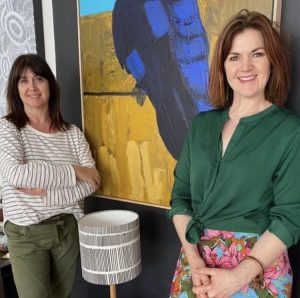
Stephanie Day (right) with artist Anna Blatman.
Stephanie Day is the Gallery Director/Curator at Paper Pear, a beautifully curated space located in the New South Wales city of Wagga Wagga. Showcasing an eclectic mix of art in all its forms, the gallery provides artists with exciting opportunities to connect with regional art lovers.
So, how does Stephanie find the work that fills her gallery walls, how do artists attract her attention and what are her dos and don’ts for artists wanting to connect with gallerists?
Interview by Lisa Doust
When did you open the doors to Paper Pear and what inspired you to set up a regional gallery?
Paper Pear was established in 2011 as a space for me to create in and run art workshops for adults and children. I wanted to showcase my creative talents and provide a unique opportunity for my local community.
I quickly realised there was a gap in the market with limited options for locals to purchase original art, and Paper Pear morphed swiftly into a dedicated art space now showing around 50 Australian artists and makers.
What are the benefits to artists of showing their work regionally?
The biggest benefit is a new and hugely receptive audience with just as much spending power as their metropolitan cousins. Regional audiences are very used to travelling miles to shop and some of my customers will move mountains to get here!
How do you discover new artists and what makes them stand out for you?
I find my artists in a number of ways – Instagram, word of mouth, magazines and sometimes I stumble across them on my road trips! Once I see an artist I love, I’m like a terrier tracking them down.
What makes them stand out for me also varies but I get a very strong feeling that can’t be ignored, as I did when I first discovered Anna Blatman at the Canterbury Art Fair in Melbourne many years ago.
Anna wasn’t sold on the idea straight away, but my persistence paid off and now there isn’t a day when she and I don’t chat! Likewise with Catherine Stewart, who was a friend of a friend and has since gone on to leave her teaching career to pursue painting full-time!
What are the key factors you take into consideration when taking on a new artist?
Firstly, does the artist fit my aesthetic? I look for a consistency in their work and ultimately longevity – will a buyer enjoy the work for a long time, or is it ‘disposable art’?
I then look at the way the artist markets themself on social media. Does their branding align with mine? Are they represented and, if so, by how many galleries? I steer away from artists that choose quantity over quality and seem to be ‘overexposed’.
I also look at whether an artist will be able to create work on a regular basis for me. Are they a hobbyist or a full-time artist?
Also, is communication easy and do I think they will be easy to work with?
What advice would you give to artists who are thinking of approaching a gallery?
Familiarise yourself with the gallery and look at their aesthetic. Will your work fit with the style and standard of their existing artists?
Put yourself on the gallery’s radar – like their posts and comment frequently to make yourself visible. I often check out artists who comment on my posts and have even found a few of my stable this way.
Before you approach, do your research. Who are you addressing? Know their name and use it when you communicate. I don’t mind a message via Instagram or email as a first point of contact, but I notice attention to detail – bonus points for using my name – it shows you’re a professional.
DO NOT cold call a gallery, arrive unannounced with artworks or send 25 images via DM without even saying hello!
Based on your vast experience of dealing with new and emerging talent, is there any one thing you would suggest artists do to assist their professional development?
Never stop learning! Network with other artists, listen to podcasts, attend openings, seek out workshops and opportunities to hone your craft, speak to galleries, take constructive criticism and free advice, but just keep painting!
Follow Stephanie via @paperpear or visit paperpear.com
